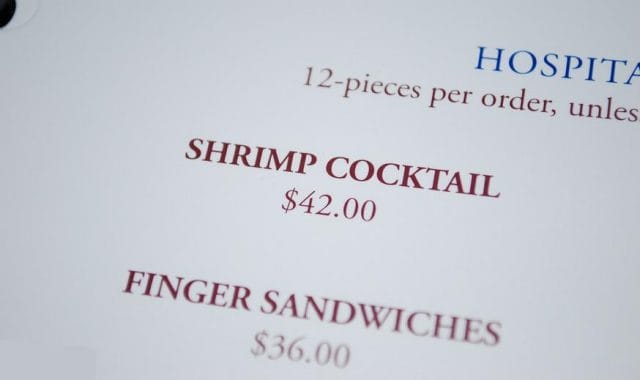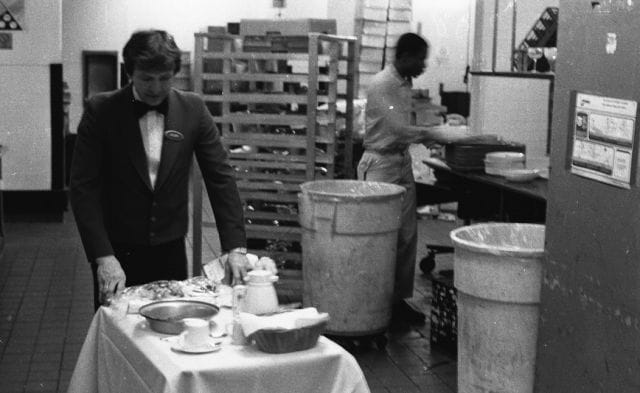
Source: Le Meridien Hotels (Flickr)
In the late 1930s, the Waldorf Astoria in New York became the first hotel in the world to offer an in-room dining service. At the time the concept was ultra-lux: guests could order a variety of food and have it delivered to their doorstep in 30 minutes. In 1969, the Westin hotel chain took the concept a bit further and began offering a 24-hour room service; customers could order caviar and lobster at 4AM if they were so inclined.
Today, room service has become a standard at most four-star (and up) rated hotels; Smith Travel Research estimates that about half of America’s 51,214 hotels offer some variation of room service. A report released by the American Hotel and Lodging Association delineates that about 40% of all hotel guests travel on business, and that these customers (as opposed to those traveling for leisure) are the most prolific room service connoisseurs.
But a Quora user poses a pertinent question: “Why is room service so ridiculously expensive?” Furthermore, how is it that even with sky-high prices, this service operates at a loss for most hotels?
Why Is a Club Sandwich $40?
Last year, travel website TripAdvisor conducted an experiment. The company’s TripIndex report analyzed the top 10 ranked 4-star hotels in a variety of U.S. cities and compared the price of a club sandwich delivered through room service.
The results may not come as a surprise to anyone who’s ordered in-room-dining:

Data sourced from TripIndex
Out of the 150 hotels (10 in each of the above 15 cities) surveyed, the average club sandwich runs about $16 — a fairly aggressive price for essentially a BTL with turkey. But wait, there’s more: these prices don’t include the requisite fees that come with all room service meals.
Typically, a 15% service fee and an “in-room dining” charge ranging from $5-12 will be added automatically to the bill. Add in tax, you’re suddenly looking at a $25+ sandwich. If you’re in Honolulu, think closer to $40.
Exorbitant room service fees don’t just apply to club sandwiches: a bagel and cream cheese at a high-end hotel runs anywhere from $12-$30; mac and cheese made with Velveeta (essentially a $2 box of Kraft) is often $23; a few cookies and a glass of milk might set you back $20. Why are items that typically only cost a few dollars so expensive on a room service menu?

Source: Michael P D’Arco (Flickr)
One reason is that hotels exercise price discrimination. Pricing room service above cost allows a hotel to charge more to those who have more money to spend; if a guest is willing to shell out $400 for a night in an opulent room, they are probably willing to also pay above market price for eggs and toast if offered the convenience of delivery. Those who value saving time enough to order room service are likely also people who make a lot of money with their time, and have the cash to spend on the service.
Another factor that plays into this is consumer myopia, or the underestimation by a consumer as to how much additional services will cost for a purchased good or service. That is, when a guest sees a $12 sandwich on a room service menu, they don’t take into consideration the additional charges that will make it much more expensive (usually, these stipulations are in minuscule print at the bottom of the menu).
But the biggest factor is that there is a willingness to pay. People often arrive at a hotel tired and hungry, and don’t have the energy to venture out into unfamiliar territory to go meal-hunting. Americans are also more likely to splurge on luxuries while on vacation.
How Profitable is Room Service for Hotels?
With numbers like this, you’d think hotels would make a killing off of late night hunger pains. On the contrary, most hotels actually lose money on the service; for major chains, it’s neither practical nor lucrative.
Robert Mandelbaum, director of information services for PKF Hospitality Research, says room service only accounts for 1% of the typical hotel’s revenue. In addition, room service is on a rampant decline: in 2007, average yearly revenue per room was $1,150; today, it’s only $866 — about $2.37 in room service charges per room per day. While the number of hotel guests overall has risen in the last six years, room service use has fallen off 25 percent.
Mandelbaum likens room service to other hotel offerings, like a pool:
“Ninety percent of people will say they want to stay at a hotel with a pool, even though only 10 percent will actually use it.”
But room service isn’t just an economic non-factor for hotels — it’s grossly inefficient. Services that are offered 24/7 require a full kitchen staff to be ready and prepared around the clock. Taking this into consideration, it costs more to produce each item of food that it would for a restaurant operating during dining hours with a steady flow of customers. Sustaining room service clerks’ salaries alone sets back the average hotel more than they make in nightly revenue

Source: Roberto Arevalo (Flickr)
For this reason, Jacob Tomsky, who used to work at a high-end hotel in New Orleans, says hotel room service is trending toward nonsensical:
“The money has never made sense. The cost of keeping a kitchen active through the night, of paying the attendants to stay awake and caffeinated, has never been covered by the three drunk guests who order fries at 4 a.m.”
So why do hotels even bother offering room service if it’s clearly a dying art form? In short, it’s the norm. One guest at a posh Chicago hotel voices an opinion on the matter that summates exactly why hotels remain locked into this model:
“There are so many hotels to choose from. If everyone is offering room service, I don’t know why I would pay the same rate with no service.”
Since becoming standard fare for nice hotels over the last 40 years, room service has now become a matter of keeping up appearances and staying competitive. Many travel guides and rating systems even require a hotel to have room service to merely qualify for a four or five-star rating.
What the Future Holds for In-Room Dining
Last year, New York’s Hilton Midtown — the city’s second largest hotel — discontinued room service to all 2,000 of its rooms, citing high staff costs and inconsistent demand. They cut 55 employees from their room service staff, and implemented “Herb n’ Kitchen,” a refrigerator stocked with grab-and-go items.
Though Omni Hotels executive David Morgan says he “[doesn’t] see room service going away any time in the near future,” there is definitely a wind of change in the industry. Several other large hotels have made efforts to scale back menus and cut round-the-clock hours; many newer hotels opening now have foregone the service altogether, touting methods which utilize new technologies.
One such alternative, Moving Menus, allows hotel guests to order off of an in-room menu from a variety of local restaurants, who then deliver the food to the room. The company’s website appeals to hotels vexed by costly kitchens: “There’s no cost to you — yet you can offer your guests a complete in-room dining service.”
Other food delivery mobile applications — GrubHub, Seamless, Eat24, Caviar, et. al. — are gaining similar traction with hotel guests looking for alternative local options.
Whatever the future holds for traditional hotel room service, one thing is certain: there’s got to be a better option than a $40 club sandwich.
This post was written by Zachary Crockett. Follow him on Twitter here, or Google Plus here.



